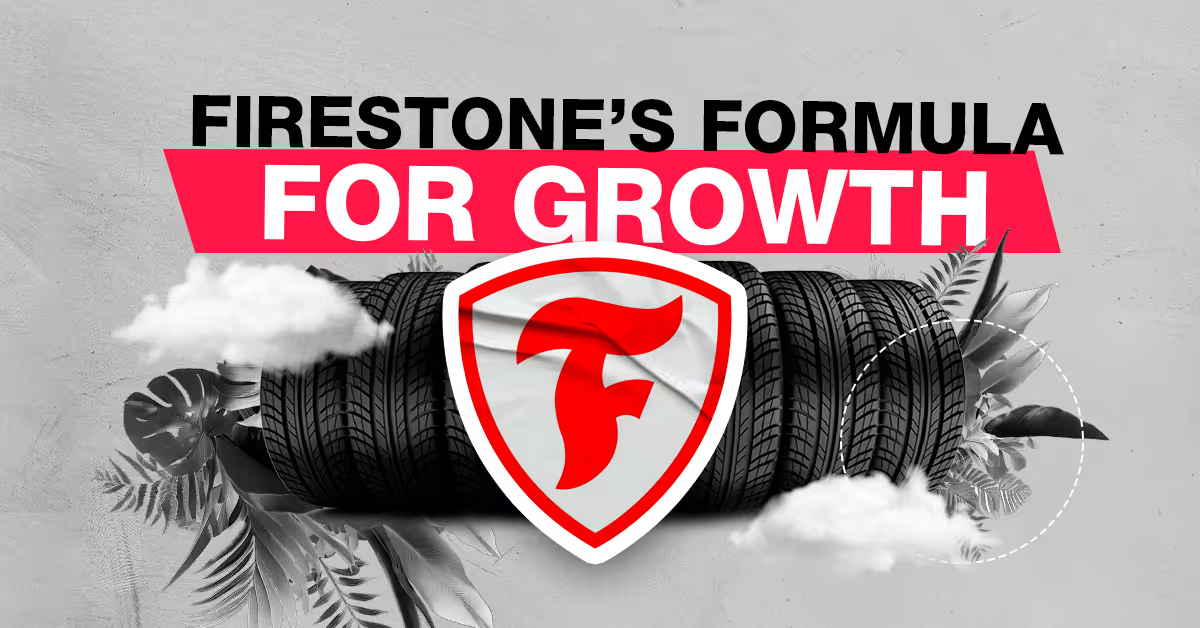
In the competitive automotive aftermarket industry, finding inspiration from established players can transform your marketing approach. As someone who's spent years helping automotive parts retailers boost their online presence, I've become fascinated with how traditional brick-and-mortar giants have adapted their marketing strategies over time. Firestone's approach offers valuable lessons that are directly applicable to today's digital-first automotive parts marketplace.
What makes Firestone's marketing strategies worth studying? Their ability to balance traditional expertise with modern training methods stands out as particularly relevant for today's aftermarket brands. Their focus on education rather than just promotion creates lasting value for both employees and customers.
Let's examine the specific marketing lessons from Firestone that can benefit automotive parts retailers and manufacturers looking to strengthen their market position in today's environment.
When most automotive brands think about marketing, they immediately focus on customer-facing campaigns. But Firestone's approach reveals something more fundamental: marketing begins with internal education. The company's ProCert program demonstrates how structured training directly impacts business results.
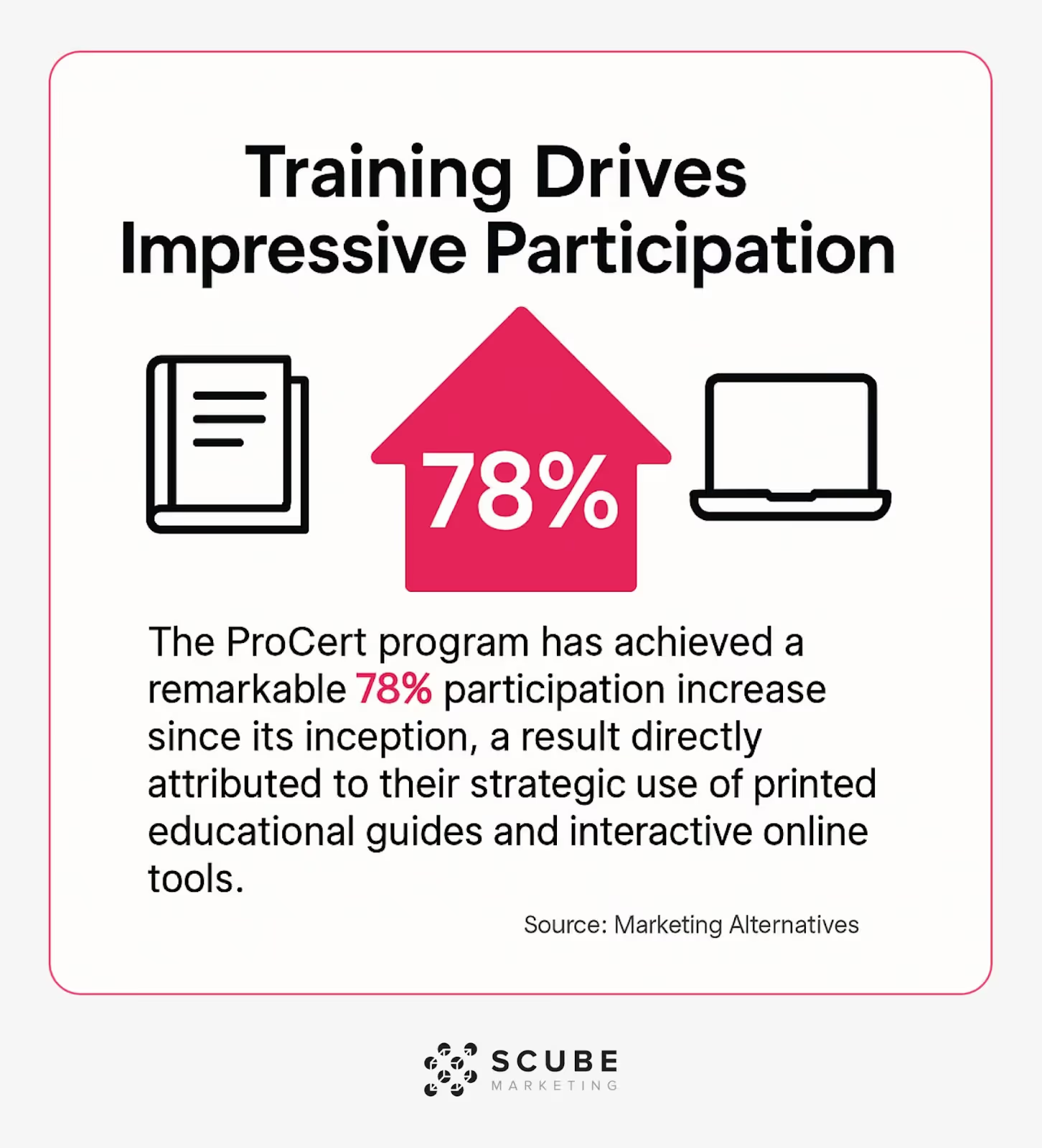
The ProCert program has achieved a remarkable 78% participation increase since its inception, a result directly attributed to their strategic use of printed educational guides and interactive online tools. (Source: Marketing Alternatives)
For automotive parts retailers, this highlights an often overlooked truth: your staff's product knowledge directly influences customer confidence and sales success. When your team fully understands your products, they become more effective marketers than any advertisement.
What makes Firestone's training program particularly effective is its clear structure. The company didn't just create random training materials. They developed a systematic approach with defined objectives, consistent delivery methods, and measurable outcomes.
This structured approach works equally well for online parts retailers. Having a systematic training program ensures consistent product knowledge across all customer touchpoints. This consistency builds trust with customers who receive reliable information regardless of how they interact with your brand.
This structured approach to training creates a foundation for consistent customer experiences. Each element builds upon the next to create a comprehensive knowledge base that directly impacts customer interactions.

What truly sets Firestone's approach apart is their focus on measurable outcomes. Even their direct mail component of the ProCert program achieved a 1% response rate through incentivized quizzes and tiered learning modules. (Source: Marketing Alternatives)
While 1% might seem modest, this represents industry-standard engagement for direct mail campaigns. The key lesson here is that even training-related communications can be measured for effectiveness. This data-driven approach aligns perfectly with data-driven marketing strategies that modern automotive parts businesses should implement.
For your automotive brand, this means treating training not as an expense but as an investment with trackable returns. Set clear KPIs for your training programs and measure their impact on key business metrics like conversion rates, average order value, and customer satisfaction scores.
Another valuable lesson from Firestone is their multi-channel approach to educational materials. Rather than relying on a single format, they strategically deploy various content types to engage different learning styles and situations.
This variety in educational formats directly contributed to their program's success. The company's strategic combination of printed guides and interactive online tools drove that impressive 78% participation increase in their training program. (Source: Marketing Alternatives)
For automotive parts businesses, this highlights the importance of creating diverse content formats. Some team members learn best from reading detailed specifications, while others prefer visual demonstrations or hands-on examples. A multi-channel approach ensures you reach everyone effectively.
In today's digital-first world, it's tempting to make all training materials online-only. Yet Firestone's success with printed guides alongside digital tools shows the continued value of physical materials in certain contexts.
For automotive parts businesses, this balanced approach makes particular sense. Technical information about parts specifications, compatibility, and installation procedures often benefits from printed reference materials that can be consulted in workshop environments where digital devices might be impractical.
The key insight here is that different formats serve different purposes in your educational marketing strategy. The most effective approach combines these formats into a cohesive system that supports various learning preferences and situations.
I've found that clients who implement this multi-channel approach to educational content see higher engagement rates across their marketing materials. When you provide information in the format your audience prefers, they're more likely to engage with and retain that information.
One of the most innovative aspects of Firestone's approach is their tiered certification system. The ProCert program features distinct ranks (Professional, Expert, Master) requiring progressively complex knowledge assessments. (Source: Modern Tire Dealer)
This tiered approach recognizes that expertise develops over time and in stages. Rather than overwhelming staff with every detail at once, the program creates a clear path to mastery that acknowledges and rewards progress along the way.
For automotive parts retailers, this graduated approach is particularly valuable. The sheer volume of technical information about automotive components can be overwhelming. Breaking this knowledge into logical progression levels makes it more manageable for team members to absorb and apply.
The genius of Firestone's tiered approach lies in how it structures knowledge assessment. Each certification level builds upon previous learning while introducing new concepts at an appropriate pace. This creates a natural learning curve that keeps staff engaged and motivated.
For automotive parts businesses, a similar tiered approach might look like this:
This structured progression creates clear development paths for your team. It also provides natural opportunities to recognize and celebrate achievements, which boosts morale and encourages continued learning.
When implementing a tiered approach like this, consider how to effectively sell auto parts online at each knowledge level. Different expertise stages enable different selling approaches, from basic product matching to complex technical consultations.
Perhaps the most transferable lesson from Firestone's approach is their commitment to extending knowledge beyond specialist staff. The company deployed three guides per retail location specifically to educate non-specialized staff, expanding their audience reach beyond core tire technicians. (Source: Marketing Alternatives)
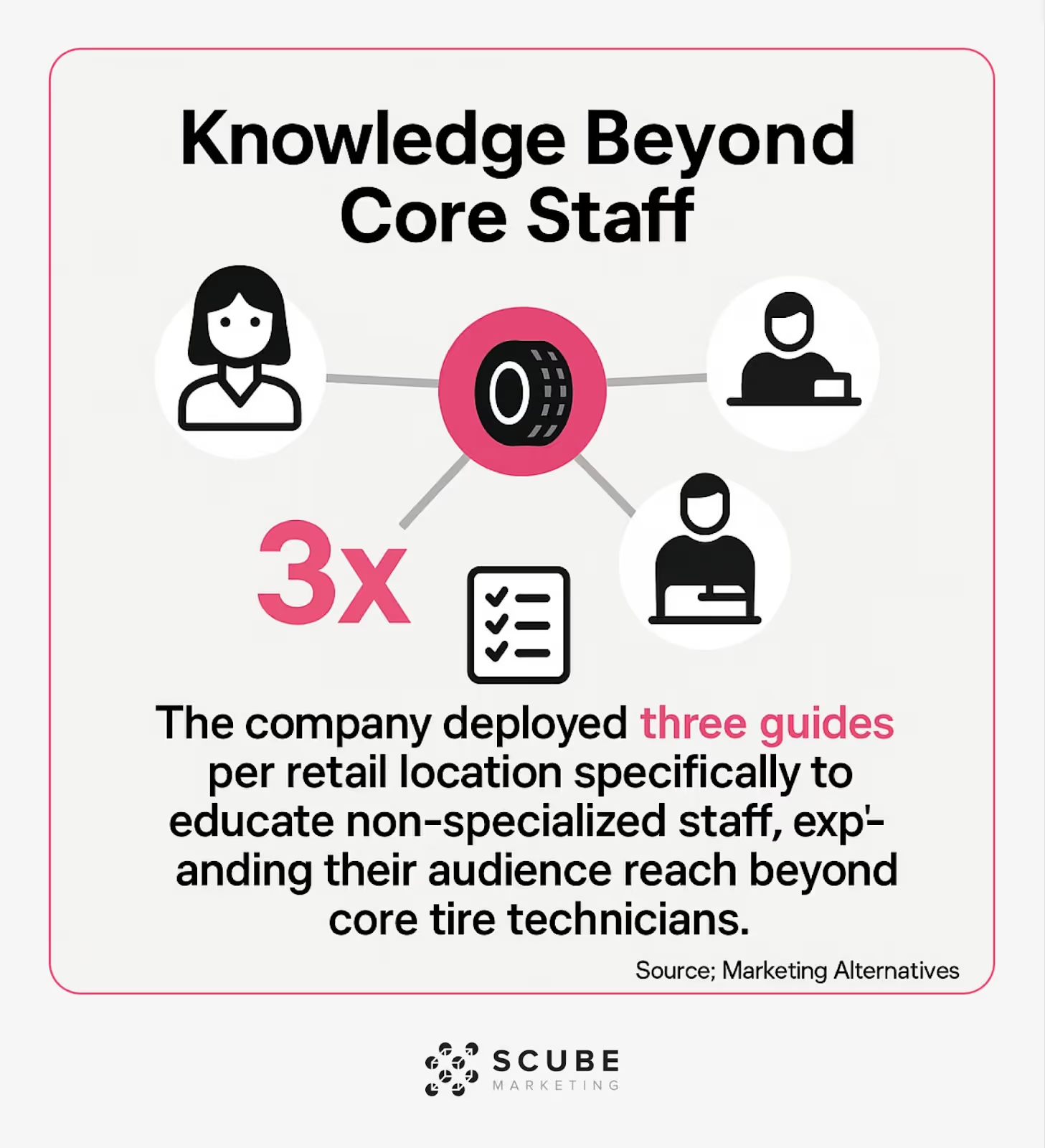
This inclusive approach recognizes that every staff member who interacts with customers shapes brand perception. From receptionists to cashiers, each employee represents an opportunity to reinforce expertise and build customer confidence.
For automotive parts businesses, this lesson is particularly relevant. While technical specialists certainly need deep product knowledge, customer service representatives, warehouse staff, and marketing team members all benefit from understanding your products at an appropriate level for their role.
Key Insight
When everyone in your organization understands your products, they become natural brand advocates who can reinforce your marketing messages in every customer interaction, whether in-person or online. Explore how aftermarket automotive businesses can implement training programs that build organization-wide product knowledge.
This inclusive approach to knowledge sharing creates consistency across all customer touchpoints. When everyone understands your products and value proposition, they naturally reinforce your marketing messages in authentic ways.
The key to successfully extending knowledge throughout your organization is recognizing that different roles need different types and depths of information. Firestone's approach of creating specific guides for non-specialized staff acknowledges this reality.
For automotive parts businesses, a role-specific approach might include:
This targeted approach ensures that everyone has the knowledge they need for their specific role while avoiding information overload. It creates a more efficient learning process that directly supports business objectives.
Now that we've examined the key marketing lessons from Firestone's approach, let's discuss how you can implement these insights in your automotive parts business. The goal is to adapt these strategies to fit your specific market position and resources.
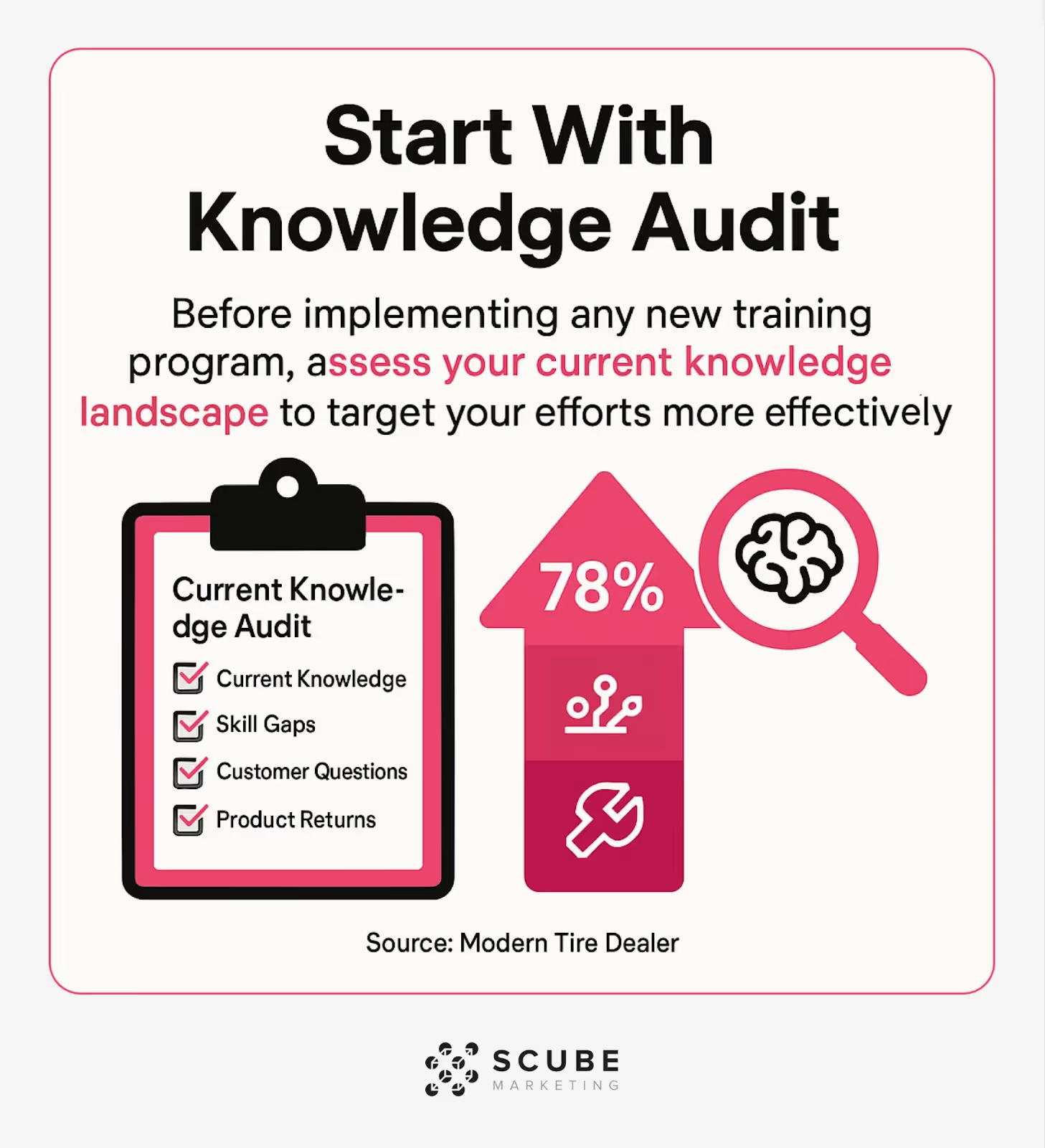
Before implementing any new training program, assess your current knowledge landscape. Understanding where expertise already exists and where gaps need to be filled helps you target your efforts more effectively.
The most successful aftermarket auto parts e-commerce strategies begin with a clear understanding of internal capabilities. Knowing what product knowledge your team currently possesses helps you build training programs that address specific needs rather than covering information everyone already knows.
A simple knowledge audit might include:
This audit provides the foundation for a targeted training program that addresses your specific business needs.
Once you understand your knowledge landscape, develop a phased implementation plan that prioritizes high-impact areas. Starting with manageable sections allows you to demonstrate success quickly and build momentum for broader implementation.
This phased approach makes implementation more manageable while allowing you to adjust based on early results. It also creates natural points to celebrate successes and maintain momentum.
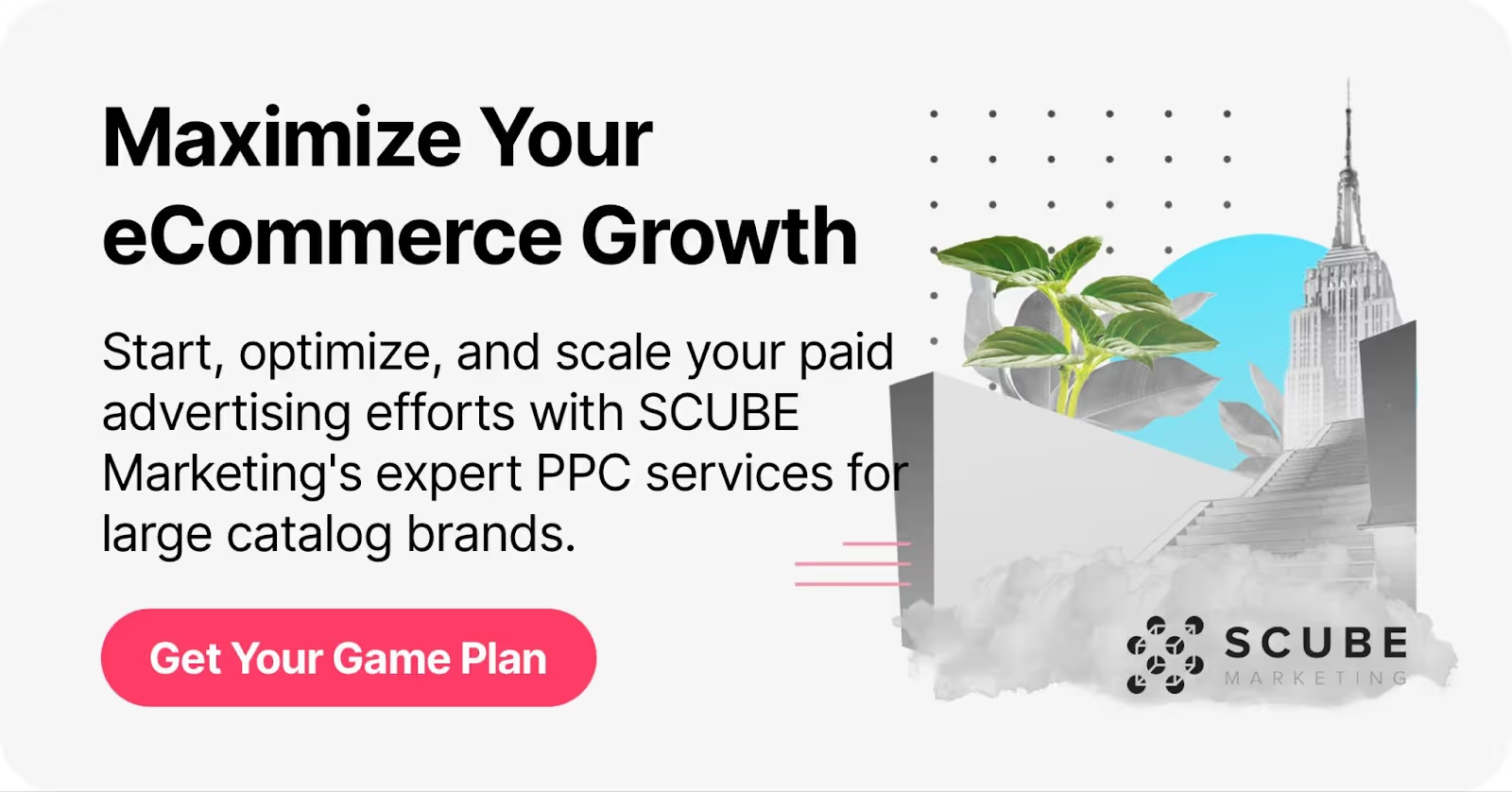
The most powerful insight from Firestone's marketing approach is how they've positioned education as a core marketing strategy rather than just an internal operation. Their ProCert program demonstrates that when you invest in knowledge development, you create marketing advantages that extend far beyond traditional advertising campaigns.
For automotive parts businesses, this education-focused approach offers several distinct advantages:
As we've seen from Firestone's 78% participation increase in their training program, structured educational initiatives drive measurable results. (Source: Marketing Alternatives)
The automotive aftermarket continues to evolve rapidly, with new technologies, changing consumer expectations, and increasing competition. In this environment, the companies that invest in developing and sharing product knowledge will have a distinct advantage over those focused solely on traditional marketing approaches.
What's your next step? Consider starting with a simple knowledge audit to identify your biggest opportunities. Then develop a structured training program that extends product knowledge throughout your organization. The results might surprise you – not just in team performance, but in marketing effectiveness and customer satisfaction.